
Press » The Lily Limp: Ernest H. (“Chinese”) Wilson and Chinese Lilies

The huge white fragrant lilies known as “Regal lilies”, (Lilium regale) are almost universally beloved. The only thing some people might have against them is their sheer size. Not everyone has a back garden which can accommodate a six foot tall lily be it never so gorgeous. Did you ever wonder where they came from and what was involved in getting theme back from the country of their origin? Ernest Wilson and his “lily limp” tell that story.
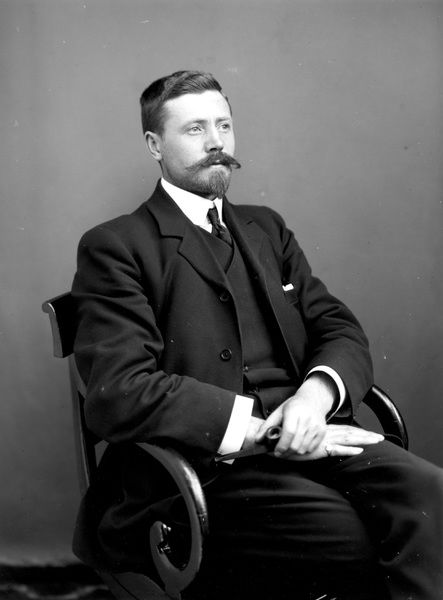
Ernest Henry Wilson
By 1870 more than half the ornamental plants grown and sold in the West came from Far Eastern sources, principally China. (If anyone is interested in this history I documented it in my book, “The Global Migrations of Ornamental Plants: how the world got into your garden” (2009)). Other sources of exotic beauties were the Southern Hemisphere: the Cape of Good Hope in South Africa, Australia, New Zealand, Chile, Peru and in Central America, Mexico.
North America was one of the mainstays of new plants arriving in England and the Continent in the eighteenth century. The entire landscape of Scotland was changed by the arrival of Western American conifers. Maples and azaleas from the South Eastern states influenced British gardening permanently.
North America was one of the mainstays of new plants arriving in England and the Continent in the eighteenth century. The entire landscape of Scotland was changed by the arrival of Western American conifers. Maples and azaleas from the South Eastern states influenced British gardening permanently.
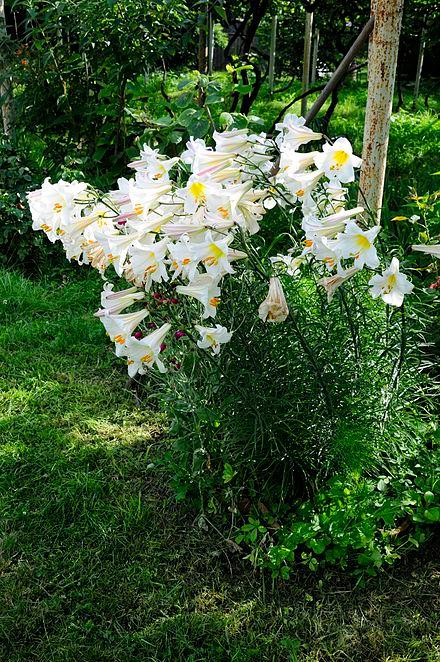
Lilium regale
The Far Eastern countries could not be entered safely until the mid-nineteenth century but once that was achieved (by highly questionable means) new plants flooded in. After the Opium Wars (1839- 1842 and 1856 -1860) English and French plant explorers in the main were able to go past the tiny foreign settlements, for example in Canton and Hong Kong, into the hinterlands. One of the greatest of all the explorers, Robert Fortune, prophesied that nothing would come of that barren rock Hong Kong… The volume of plant discoveries increased exponentially in the succeeding decades, reaching a tipping point by 1870 in the United States.
Leading horticulturists in Great Britain mobilized in various ways to get their hands on this booty. Large nursery firms found it lucrative to pay for a plant collector solely to supply them alone with new discoveries. These plants were sold at enormous prices, largely covering the cost of the expeditions. In an earlier essay I mentioned the Duke of Devonshire’s obsession with rare plants of all sorts but particularly orchids. A firm like John Veitch only needed a few customers like him to flourish.
The Royal Horticultural Society and the Royal Botanic Gardens at Kew also sent their own collectors. Another way this was done was for a group of wealthy landowners to form a consortium to fund the explorer’s travels. In the United States the federal government, finding itself left behind, set up its own collecting programme, sending specially equipped ships all over the world.
We can now finally think about the title person, Ernest Henry Wilson, in context. Yet again there was a very gifted lad of modest circumstances whose intelligence and application carried him far. Ernest Henry Wilson was born in Chipping Camden in 1876 but the family moved to Warwickshire when he was quite young. It is entirely possible that he is the most well known citizen of Chipping Camden. He was apprenticed to a gardener but like Joseph Paxton managed to imbibe a fair amount of general education at the same time. He travelled regularly to Birmingham for classes in science. The college gave him a diploma that opened the door for him to a job at Kew in 1897.
Leading horticulturists in Great Britain mobilized in various ways to get their hands on this booty. Large nursery firms found it lucrative to pay for a plant collector solely to supply them alone with new discoveries. These plants were sold at enormous prices, largely covering the cost of the expeditions. In an earlier essay I mentioned the Duke of Devonshire’s obsession with rare plants of all sorts but particularly orchids. A firm like John Veitch only needed a few customers like him to flourish.
The Royal Horticultural Society and the Royal Botanic Gardens at Kew also sent their own collectors. Another way this was done was for a group of wealthy landowners to form a consortium to fund the explorer’s travels. In the United States the federal government, finding itself left behind, set up its own collecting programme, sending specially equipped ships all over the world.
We can now finally think about the title person, Ernest Henry Wilson, in context. Yet again there was a very gifted lad of modest circumstances whose intelligence and application carried him far. Ernest Henry Wilson was born in Chipping Camden in 1876 but the family moved to Warwickshire when he was quite young. It is entirely possible that he is the most well known citizen of Chipping Camden. He was apprenticed to a gardener but like Joseph Paxton managed to imbibe a fair amount of general education at the same time. He travelled regularly to Birmingham for classes in science. The college gave him a diploma that opened the door for him to a job at Kew in 1897.
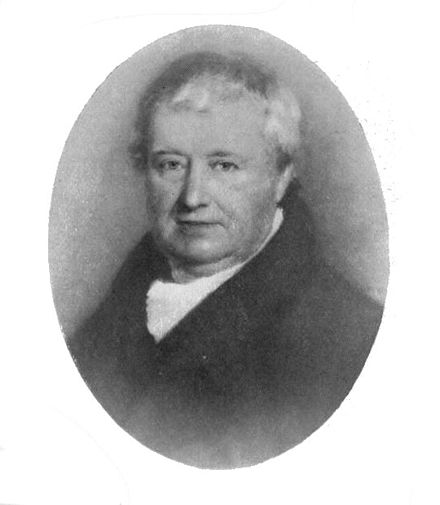
John Veitch
John Veitch, 1752 – 1839, was a very canny Scotsman who had worked in a tree nursery in the Scottish Lowlands while all the conifers were pouring into Britain and also set up a successful landscaping business. That gave him enough capital to open a general nursery in Exeter and then a branch in London in the fashionable district of Chelsea. He made sure only the best people were his customers and he treated each one as if he or she were royalty. The heavy lifting was done in Exeter and the Chelsea shop was all sweetness and light. The Veitch family maintained the Chelsea business until 1917 but as there were no heirs in the pipeline Sir Harry Veitch chose to close it down and sell rather than let it limp along with inferior leadership. The Veitch nursery in Exeter lasted longer.
Veitch’s grandson realized the value in obtaining rare plants that no one else would have in stock, rather like a couturier creating unique garments. To that end he consulted the staff at Kew about a likely person to carry out his wishes. The head gardener had formed a very good impression of young Wilson and recommended him to the director, William Thistelton -Dyer.
Wilson was single without responsibilities and accepted the offer. Veitch drove a very hard bargain. There was almost never quite enough money for Wilson while he was away and he had to account literally for every penny he spent. We can only very dimly imagine what it must have been like to travel around China in 1900. It was still a client state of Great Britain with British Customs and other institutions but once you left the sophisticated coastal cities things were very different.
Wilson’s own writings leave us feeling that he went through truly ghastly experiences but that he was putting a good face on it. There is no doubting the sincerity of his joy at finding new plants.
There were no huge glossy airports or supersonic railways in 1900 when he first entered China. The great river systems of the Yangste, the Yellow River, the Salween and the Mekong provided the best way to get around but in the mountains the traveler was lucky if he could find a mule or a donkey. The equipment was carried by porters. The rivers had many impassable sections in deep gorges and portage was the only way to get around the obstruction. This was all before the dams were built later in the twentieth century to reduce the worst of the flooding in the fertile plains
Crops failed very often and the local villagers had no food to spare. They barely had enough for themselves and survived close to starvation much of the time. Many families were so poor that there was only one suit of clothes to go round between them. There was absolutely no modern medical care. To make it all worse, if that is possible, the rural Chinese were very suspicious of foreigners whom they considered to be “devils” and gangs of bandits infested the countryside.
Veitch’s grandson realized the value in obtaining rare plants that no one else would have in stock, rather like a couturier creating unique garments. To that end he consulted the staff at Kew about a likely person to carry out his wishes. The head gardener had formed a very good impression of young Wilson and recommended him to the director, William Thistelton -Dyer.
Wilson was single without responsibilities and accepted the offer. Veitch drove a very hard bargain. There was almost never quite enough money for Wilson while he was away and he had to account literally for every penny he spent. We can only very dimly imagine what it must have been like to travel around China in 1900. It was still a client state of Great Britain with British Customs and other institutions but once you left the sophisticated coastal cities things were very different.
Wilson’s own writings leave us feeling that he went through truly ghastly experiences but that he was putting a good face on it. There is no doubting the sincerity of his joy at finding new plants.
There were no huge glossy airports or supersonic railways in 1900 when he first entered China. The great river systems of the Yangste, the Yellow River, the Salween and the Mekong provided the best way to get around but in the mountains the traveler was lucky if he could find a mule or a donkey. The equipment was carried by porters. The rivers had many impassable sections in deep gorges and portage was the only way to get around the obstruction. This was all before the dams were built later in the twentieth century to reduce the worst of the flooding in the fertile plains
Crops failed very often and the local villagers had no food to spare. They barely had enough for themselves and survived close to starvation much of the time. Many families were so poor that there was only one suit of clothes to go round between them. There was absolutely no modern medical care. To make it all worse, if that is possible, the rural Chinese were very suspicious of foreigners whom they considered to be “devils” and gangs of bandits infested the countryside.
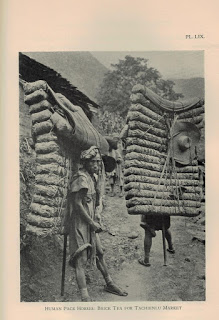
Human Packhorses
from EH Wilson,
China, Mother of Gardens, 1929
By 1899, when Wilson was sent out to collect, Veitch had many samples of exotic plants but one still eluded them. The “dove tree”, Davidia involucrata, was hung with huge white bracts that fluttered in the wind, giving the impression of a flock of doves on the wing. It was rare even in China but the indefatigable Dr Augustine Henry of the British Chinese Customs Service, a legendary collector, had seen one. Wilson was instructed to find Dr Henry and reach the tree. This was his sole task and he was sternly warned not to waste time or get distracted by looking for anything else.
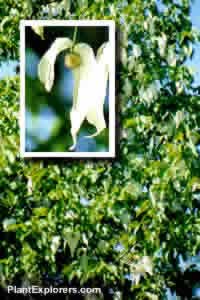
Davidia involucrata
Wilson travelled up the Red River to I-chang, the border with French Indo-China where the British had installed a customs station. Henry told him where to go but when he reached the village the tree had gone. It had been cut down to make way for a house. Most of us would have burst into tears but Wilson was made of sterner stuff. He persevered and found other specimens some distance away. During this interval he found it impossible to resist the great floral riches he passed and packed case after case of glorious plants or their seed to send back to London. Veitch made very stormy noises but was actually tickled pink to have all this material. The Davidia trees flourished and Veitch made a killing on them.
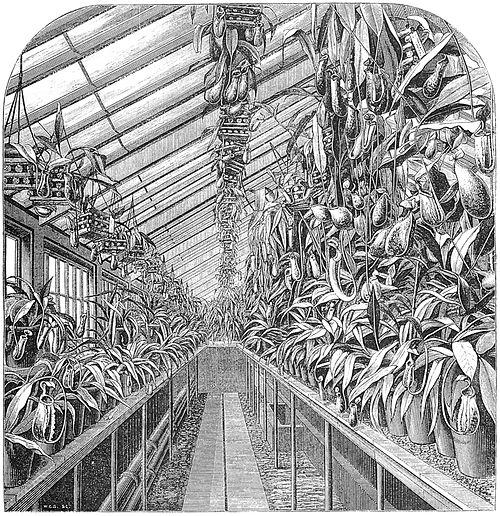
Nepenthes, growing in a Veitch Greenhouse
In all Wilson worked in China for eleven years. The first six were for Veitch but the latter five were for the Arnold Arboretum in Jamaica, Massachusetts, part of Harvard University. Veitch had sent him to the arboretum for a few months training to learn the best ways of transporting plants and seed from the director, Dr Charles Sargent, before heading out to China. Sargent had brought back superb plants from Japan and was a noted authority. He liked Wilson and offered him a post at the Arboretum once he fulfilled his contract with Veitch.
Wilson was glad to change. He had married and had one child. Sometimes he was able to take his little family with him. In 1903 he found vast valleys full of Lilium regale. While he was collecting there was an avalanche across the pass on which he was traveling. He fell and broke his leg very badly but had to lie still while the mules stepped across him one by one before his porters could get him down to a town for care. The doctor there thought he might have to amputate the leg at first but Wilson prevailed on him not to do that. He always walked with a limp after that, his “lily limp”.
When Sargent retired he invited Wilson to take over the arboretum. Wilson preferred the title of “Keeper of the Arboretum” rather than director. In 1930, while traveling near Worcester, Massachusetts, Wilson and his wife were killed in a car accident. Their daughter Helen wanted them to buried in British soil but could not handle sending their bodies back to England. She decided to have them cremated and have the ashes buried in Canada, the closest facsimile of British soil she could find.
Knowing all this makes me look at flowers in a whole new way. Ernest Wilson discovered more than 2000 species of ornamental plants in China, adding immeasurable beauty to Western gardening. The taxonomists at the arboretum published an authoritative list of them, fully identified and named, as “Plantae Wilsonianae in 1913.
Really, really last word: he intensely disliked being called “Chinese” Wilson.
References
Fortune, Robert 184- Three Years in China
Sargent, Charles Sprague ed 1913 re issued 1988 Plantae Wilsonianae
Cambridge, Massachusetts Harvard University Press
Taylor, Judith M. 2009 The Global Migrations of Ornamental Plants: how the world got into your garden.
St LouIs, Missouri Missouri Botanical Garden Press
Wilson, Ernest Henry 1929 China: mother of gardens
Boston The Stratford Company
Wilson was glad to change. He had married and had one child. Sometimes he was able to take his little family with him. In 1903 he found vast valleys full of Lilium regale. While he was collecting there was an avalanche across the pass on which he was traveling. He fell and broke his leg very badly but had to lie still while the mules stepped across him one by one before his porters could get him down to a town for care. The doctor there thought he might have to amputate the leg at first but Wilson prevailed on him not to do that. He always walked with a limp after that, his “lily limp”.
When Sargent retired he invited Wilson to take over the arboretum. Wilson preferred the title of “Keeper of the Arboretum” rather than director. In 1930, while traveling near Worcester, Massachusetts, Wilson and his wife were killed in a car accident. Their daughter Helen wanted them to buried in British soil but could not handle sending their bodies back to England. She decided to have them cremated and have the ashes buried in Canada, the closest facsimile of British soil she could find.
Knowing all this makes me look at flowers in a whole new way. Ernest Wilson discovered more than 2000 species of ornamental plants in China, adding immeasurable beauty to Western gardening. The taxonomists at the arboretum published an authoritative list of them, fully identified and named, as “Plantae Wilsonianae in 1913.
Really, really last word: he intensely disliked being called “Chinese” Wilson.
References
Fortune, Robert 184- Three Years in China
Sargent, Charles Sprague ed 1913 re issued 1988 Plantae Wilsonianae
Cambridge, Massachusetts Harvard University Press
Taylor, Judith M. 2009 The Global Migrations of Ornamental Plants: how the world got into your garden.
St LouIs, Missouri Missouri Botanical Garden Press
Wilson, Ernest Henry 1929 China: mother of gardens
Boston The Stratford Company
English Historical Fiction Authors, October 9, 2019

